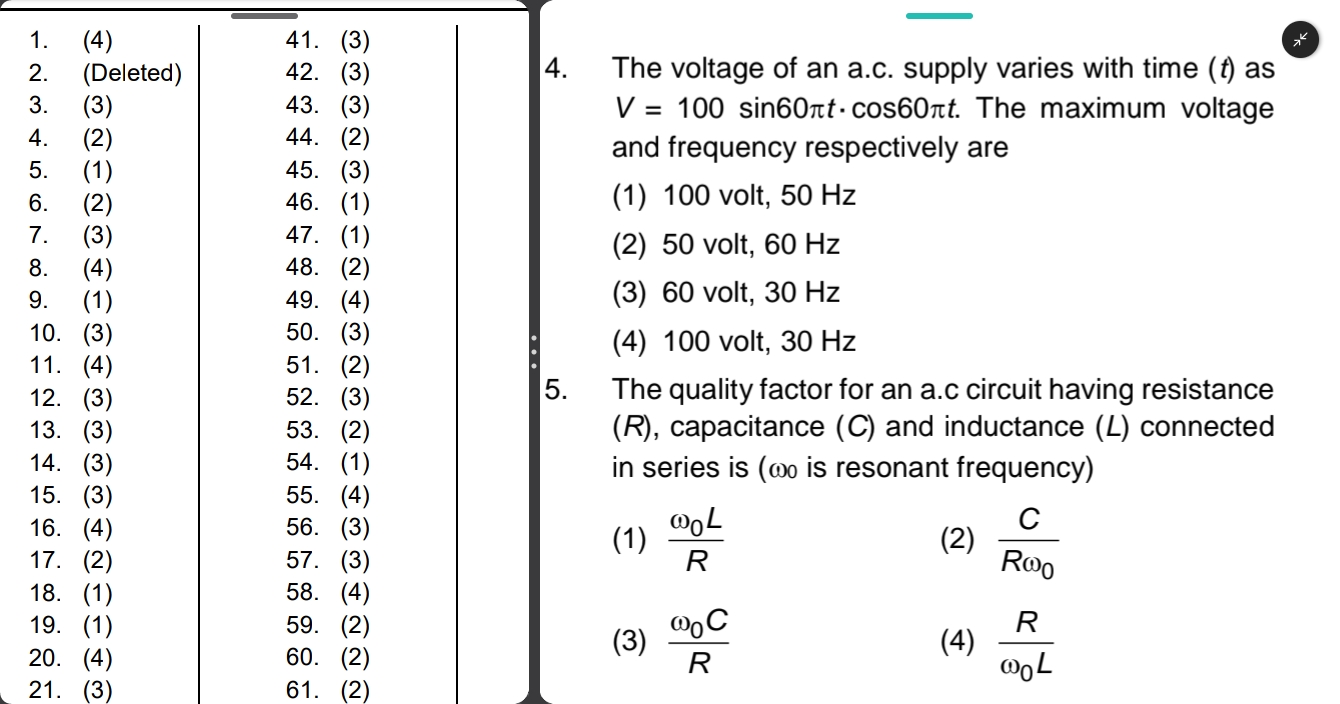The voltage of an a.c. supply varies with time (t) as V = 100 sin(60πt) · cos(60πt). The maximum voltage and frequency respectively are (1) 100 volt, 50 Hz (2) 50 volt, 60 Hz (3) 6... The voltage of an a.c. supply varies with time (t) as V = 100 sin(60πt) · cos(60πt). The maximum voltage and frequency respectively are (1) 100 volt, 50 Hz (2) 50 volt, 60 Hz (3) 60 volt, 30 Hz (4) 100 volt, 30 Hz. The quality factor for an a.c circuit having resistance (R), capacitance (C) and inductance (L) connected in series is (ω₀ is resonant frequency) (1) ω₀L/R (2) C/Rω₀ (3) ω₀C/R (4) R/ω₀L.

Understand the Problem
The question is asking for the maximum voltage and frequency of an alternating current (A.C.) voltage supply given in a mathematical form. It also asks for the quality factor of an A.C. circuit with specific components. The problem revolves around understanding A.C. circuits and their parameters.
Answer
The maximum voltage is $100 \, \text{volts}$ and the frequency is $30 \, \text{Hz}$.
Answer for screen readers
The maximum voltage is 100 volts, and the frequency is 30 Hz.
Steps to Solve
- Identify Maximum Voltage from the Equation
The voltage is given as ( V = 100 \sin(60\pi t) \cos(60\pi t) ). The maximum voltage occurs at the amplitude of the sine and cosine components:
The amplitude here is clearly 100 volts.
- Calculate Frequency
From the sine and cosine functions, the coefficients in the standard form ( V = A \sin(\omega t) ) and ( V = A \cos(\omega t) ) help identify the angular frequency ( \omega ).
Here, ( \omega = 60\pi ).
The frequency ( f ) can be calculated using the relation:
$$ f = \frac{\omega}{2\pi} $$
Substituting ( \omega ):
$$ f = \frac{60\pi}{2\pi} = 30 \text{ Hz} $$
- Conclude Maximum Voltage and Frequency
Summarizing the findings:
- Maximum Voltage = 100 volts
- Frequency = 30 Hz
The maximum voltage is 100 volts, and the frequency is 30 Hz.
More Information
The voltage function combines sine and cosine waves, and in this case, the maximum voltage occurs at the peak amplitude, which is determined by the coefficient in front of the sine function. The frequency can be derived from the angular frequency, showing the relationship between angular frequency and standard frequency.
Tips
- Confusing angular frequency with frequency; always remember the conversion ( f = \frac{\omega}{2\pi} ).
- Misinterpreting the amplitude; only the maximum coefficient matters in calculating the peak voltage.
AI-generated content may contain errors. Please verify critical information